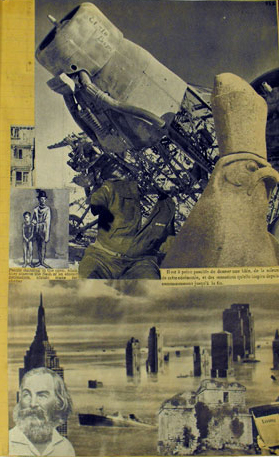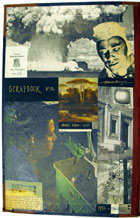Links with Surrealism
 Like the child who went forth each day able to identify with anything he happened to see, and appropriate it to himself, Morgan seems a surrealist from the start. The overall effect of the Scrapbooks, and possibly a shaping influence, is that they are somewhat surreal. He specialized in Art at high school and had access in the Art Room to a library of artworks in reproduction. Surrealism interested him greatly, as did the poetry of Dylan Thomas who was also influenced by it, and whose work he first encountered in the Faber Book of Modern Verse (1936).
Like the child who went forth each day able to identify with anything he happened to see, and appropriate it to himself, Morgan seems a surrealist from the start. The overall effect of the Scrapbooks, and possibly a shaping influence, is that they are somewhat surreal. He specialized in Art at high school and had access in the Art Room to a library of artworks in reproduction. Surrealism interested him greatly, as did the poetry of Dylan Thomas who was also influenced by it, and whose work he first encountered in the Faber Book of Modern Verse (1936).
Discussing this artistic movement in Colin Nicholson’s Poem, Purpose and Place (1992), EM reached down his own well-worn copy of Herbert Read’s Surrealism (1936), containing the French poet Paul Edouard’s essay ‘Poetic Evidence’ which states that
every surrealist strives to unite the imagination and nature, to consider all possibilities a reality, to prove to us that no dualism exists between imagination and reality, that everything the human spirit can conceive and create springs from the same vein, is made of the same matter as his flesh and blood, and the world about him. (Poem, Purpose and Place: 66)
The Scrapbooks may be an attempt by the poet to bring the fascinating multiplicity of nature and the technological world into a unity, at least within the covers of each book.
Go to next section Scrapbooks: Publishing
Quick Links
More images from the scrapbooks

- Inside cover of Scrapbook 12 (MS Morgan C/12)

